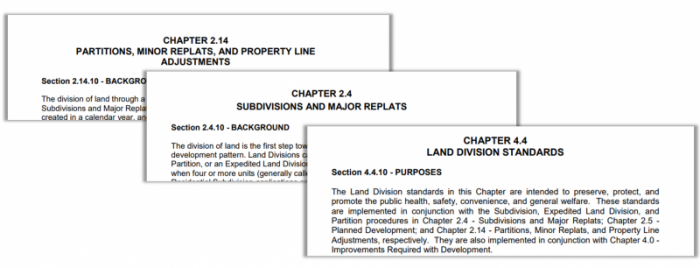Code Audit Project
What is the Code Audit?
In 2018, the City received a grant from the state to pay for a third party expert to review the Land Development Code and identify any legal problems or standards that created barriers to affordable housing. The consultant worked with a committee of local experts and completed this work in 2019. The final code audit report is available here:
The City is now in the process of revising the Land Development Code, to implement the findings of the code audit study. Due to the scope of the audit, which involved a review of all four articles of the code, implementing changes to the code will occur as a multi-phased project, described below.
Phase 1: Land Divisions
Status (Phase 1): Completed. City Council adopted ordinance at its November 1, 2021 public hearing. Code changes are effective November 24, 2021.
Land division is a key part of provision of housing because it is one of the first steps in the development process – dividing land into vacant, developable portions that have immediate access to City infrastructure. Lack of clarity in rules for dividing land complicates the earliest steps of providing housing, so improving this part of the Land Development Code could play a significant role in improving the overall process of providing land for housing.
The Planning Commission held public meetings in 2019, 2020, and 2021 to review the land division standards of the Land Development Code and recommendations from the code audit. These discussions are covered in the Planning Commission materials located here:
Code Audit - Land Division Discussions - Public Meetings
One of the key recommendations to come out of these discussions is a consolidation and simplification of the land division portions of the code.

Phase 2: Block Perimeter
Status (Phase 2): Completed. City Council adopted ordinance at its November 1, 2021 public hearing. Code changes are effective November 24, 2021.
One regulation that the committee felt was the most significant barrier to providing more affordable housing was the City’s small block sizes, also known as “block perimeter” standards.
The attached video presentation provides an overview of block perimeter standards. Block perimeter standards seek to ensure that the layouts for new developments facilitate access between properties and support non-motorized transportation choices like walking and bicycling. They are also a key element in defining the form of neighborhoods and setting the framework for either concentrating or dispersing vehicular traffic on the street network.
Click here to view this video on our vimeo page.
Public feedback from this video can be viewed here.
Phase 3: Residential Development Standards in Article III (Zoning) Chapters
Status (Phase 3): Completed. City Council adopted ordinance 2025-03 at its March 17, 2025 public hearing. Code changes are effective March 27, 2025.
In addition to the Middle Housing code amendments adopted in 2022, this phase focused on additional "clean up" of residential Zones and Zones that allow residential uses , to ensure all housing types have a clear and objective set of procedures and standards. The main outcomes of the project were as follows:
- Remove discretionary review processes for all Residential Use types in all Residential zones and the P-AO zone.
- Eliminate remaining development standards applicable to Single Detached dwellings and Middle Housing units that scale by the number of dwelling units.
- Remove Residential Uses and Residential Building Types from the MUT zone.
- Align the RS-12, RS-20, and MUR zone private and common outdoor space requirements with the RMU-12 and RMU-20 zones and clarify the exceptions allowed for properties adjacent to City parks.
- Amend the design standards applicable to the P-AO and MUE zones to ensure that they are clear and objective.
- Update the format and structure of zoning chapters as needed to match the rest of the LDC, update references and numbering, and clean up unclear or inconsistent language.
- October 2, 2024 Planning Commission Work Session
- June 18, 2024 Planning Commission Work Session
- October 4, 2023 Planning Commission Work Session
Phase 4: Natural Features Provisions including Minimum Assured Development Area (MADA) and Article IV Cleanup
Status (Phase 4): Planning Commission work sessions are ongoing
Anticipated Completion: 2025
- November 6, 2024 Planning Commission Work Session
- January 3, 2024 Planning Commission Work Session
- November 15, 2023 Planning Commission Work Session
- July 5, 2023 Planning Commission Work Session
- June 21, 2023 Planning Commission Work Session
How Can I Get Involved?
All Planning Commission meetings are open to the public. If you have specific questions or comments regarding the code amendments, please contact the Planning Division.